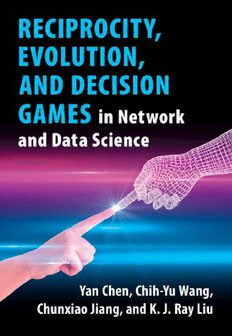
Reciprocity, Evolution, and Decision Games in Network and Data Science PDF
Preview Reciprocity, Evolution, and Decision Games in Network and Data Science
Reciprocity,Evolution,andDecisionGamesinNetworkandDataScience Learnhowtoanalyzeandmanageevolutionaryandsequentialuserbehaviorsinmod- ernnetworks,andhowtooptimizenetworkperformancebyusingindirectreciprocity, evolutionary games, and sequential decision-making. Understand the latest theory without the need to go through the details of traditional game theory. With practical management tools to regulate user behavior and simulations and experiments with real data sets, this is an ideal tool for graduate students and researchers working in networking,communications,andsignalprocessing. YanChen is a professor at the School of Cyberspace Security, University of Science andTechnologyofChina. Chih-YuWangisanassociateresearchfellowattheResearchCenterforInformation TechnologyInnovation,AcademiaSinica. Chunxiao Jiang is an associate professor at the School of Information Science and TechnologyatTsinghuaUniversity. K. J. Ray Liu is Distinguished University Professor at the University of Maryland, College Park. A highly cited researcher, he is a fellow of the IEEE, the American Association for the Advancement of Science (AAAS), and the National Academy of Inventors. He is the 2021 IEEE president elect. He is a recipient of the IEEE Fourier Award for Signal Processing, the IEEE Leon K. Kirchmayer Graduate Teaching Award, the IEEE Signal Processing Society 2014 Society Award, and theIEEESignalProcessingSociety2009TechnicalAchievementAward.Hehasalso co-authoredseveralbooks,includingWirelessAI (Cambridge,2019). Reciprocity, Evolution, and Decision Games in Network and Data Science YAN CHEN UniversityofScienceandTechnologyofChina CHIH-YU WANG AcademiaSinica CHUNXIAO JIANG TsinghuaUniversity K. J. RAY LIU UniversityofMaryland,CollegePark UniversityPrintingHouse,CambridgeCB28BS,UnitedKingdom OneLibertyPlaza,20thFloor,NewYork,NY10006,USA 477WilliamstownRoad,PortMelbourne,VIC3207,Australia 314–321,3rdFloor,Plot3,SplendorForum,JasolaDistrictCentre,NewDelhi–110025,India 103PenangRoad,#05–06/07,VisioncrestCommercial,Singapore238467 CambridgeUniversityPressispartoftheUniversityofCambridge. ItfurtherstheUniversity’smissionbydisseminatingknowledgeinthepursuitof education,learning,andresearchatthehighestinternationallevelsofexcellence. www.cambridge.org Informationonthistitle:www.cambridge.org/9781108494748 DOI:10.1017/9781108859783 ©2021CambridgeUniversityPress Thispublicationisincopyright.Subjecttostatutoryexception andtotheprovisionsofrelevantcollectivelicensingagreements, noreproductionofanypartmaytakeplacewithoutthewritten permissionofCambridgeUniversityPress. Firstpublished2021 PrintedintheUnitedKingdombyTJBooksLimited,PadstowCornwall AcataloguerecordforthispublicationisavailablefromtheBritishLibrary. ISBN978-1-108-49474-8Hardback CambridgeUniversityPresshasnoresponsibilityforthepersistenceoraccuracyof URLsforexternalorthird-partyinternetwebsitesreferredtointhispublication anddoesnotguaranteethatanycontentonsuchwebsitesis,orwillremain, accurateorappropriate. Contents Preface pagexiii 1 BasicGameTheory 1 1.1 Strategic-FormGamesandNashEquilibrium 1 1.2 Extensive-FormGamesandSubgame-PerfectNashEquilibrium 2 1.3 IncompleteInformation:SignalandBayesianEquilibrium 4 1.4 RepeatedGamesandStochasticGames 5 PartI IndirectReciprocity 7 2 IndirectReciprocityGameinCognitiveNetworks 9 2.1 Introduction 9 2.2 TheSystemModel 11 2.2.1 SocialNorms 12 2.2.2 ActionRules 13 2.3 OptimalActionRule 13 2.3.1 ReputationUpdatingPolicy 13 2.3.2 StationaryReputationDistribution 15 2.3.3 PayoffFunction 16 2.3.4 OptimalActionUsinganAlternativeAlgorithm 17 2.4 ActionSpreadingDuetoNaturalSelection 18 2.4.1 ActionSpreadingAlgorithmUsingtheWright–FisherModel 19 2.4.2 ActionSpreadingAlgorithmUsingtheReplicator DynamicEquation 19 2.5 EvolutionarilyStableStrategyandSimulations 20 2.5.1 BinaryReputationScenario 21 2.5.2 MultilevelReputationScenario 22 2.6 Conclusion 25 References 26 3 IndirectReciprocityGameforDynamicChannelAccess 28 3.1 Introduction 28 3.2 SystemModel 30 vi Contents 3.2.1 Action 31 3.2.2 SocialNorm:HowtoAssignReputation 31 3.2.3 PowerLevelandRelayPower 32 3.2.4 ChannelQualityDistribution 33 3.3 TheoreticalAnalysis 33 3.3.1 ReputationUpdatingPolicy 33 3.3.2 PowerDetectionandPowerDetectionTransitionMatrix 35 3.3.3 StationaryReputationDistribution 37 3.3.4 PayoffFunctionandEquilibriumoftheIndirect ReciprocityGame 38 3.3.5 StabilityoftheOptimalActionRule 41 3.4 Simulation 45 ∗ 3.4.1 EvolutionaryStabilityofOptimalActiona 45 2 3.4.2 SystemPerformance 47 3.4.3 DifferentSocialNorms 49 3.5 Conclusion 52 References 52 4 MultiuserIndirectReciprocityGameforCooperativeCommunications 55 4.1 Introduction 55 4.2 SystemModel 57 4.2.1 PhysicalLayerModelwithRelaySelection 57 4.2.2 IncentiveSchemesBasedontheIndirectReciprocityGame 59 4.2.3 OverheadsoftheScheme 60 4.2.4 PayoffFunctions 61 4.3 Steady-StateAnalysisUsingMarkovDecisionProcesses 62 4.3.1 StationaryReputationDistribution 62 4.3.2 Long-TermExpectedPayoffsatSteadyStates 63 4.3.3 EquilibriumSteadyState 65 4.4 EvolutionaryModelingoftheIndirectReciprocityGame 69 4.4.1 EvolutionaryDynamicsoftheIndirectReciprocityGame 69 4.4.2 EvolutionarilyStableStrategy 70 4.5 EnergyDetection 70 4.6 SimulationResults 72 4.7 DiscussionandConclusion 77 References 78 5 IndirectReciprocityDataFusionGameandApplicationtoCooperative SpectrumSensing 80 5.1 Introduction 80 5.2 IndirectReciprocityDataFusionGame 82 5.2.1 SystemModel 82 5.2.2 ActionandActionRule 83 Contents vii 5.2.3 SocialNorm:HowtoAssignReputation 84 5.2.4 DecisionConsistencyMatrix 84 5.2.5 ReputationUpdatingPolicy 85 5.2.6 PayoffFunction 87 5.2.7 EquilibriumoftheIndirectReciprocityDataFusionGame 89 5.3 ApplicationtoCooperativeSpectrumSensing 89 5.3.1 SystemModel 90 5.3.2 FusionGamefortheSingle-Channel(K =1)and HardFusionCase 91 5.3.3 FusionGamefortheSingle-Channel(K =1)andSoft FusionCase 95 5.3.4 FusionGamefortheMultichannel(K >1)Case 97 5.4 Simulation 99 5.4.1 TheOptimalActionRuleandItsEvolutionaryStability 99 5.4.2 SystemPerformance 101 5.4.3 Anticheating 103 5.5 Conclusion 104 References 105 PartII EvolutionaryGames 107 6 EvolutionaryGameforCooperativePeer-to-PeerStreaming 109 6.1 Introduction 109 6.2 TheSystemModelandUtilityFunctions 111 6.2.1 SystemModel 111 6.2.2 UtilityFunctions 112 6.3 AgentSelectionwithinaHomogeneousGroup 114 6.3.1 CentralizedAgentSelection 114 6.3.2 DistributedAgentSelection 114 6.3.3 EvolutionaryCooperativeStreamingGame 115 6.3.4 AnalysisoftheCooperativeStreamingGame 116 6.4 AgentSelectionwithinaHeterogeneousGroup 120 6.4.1 Two-PlayerGame 120 6.4.2 MultiplayerGame 122 6.5 ADistributedLearningAlgorithmforanESS 122 6.6 SimulationResults 123 6.7 Conclusion 128 References 128 7 EvolutionaryGameforSpectrumSensingandAccessinCognitiveNetworks 131 7.1 Introduction 131 7.2 SystemModel 133 7.2.1 NetworkEntity 133 viii Contents 7.2.2 SpectrumSensingModel 134 7.2.3 SynchronousandAsynchronousScenarios 135 7.3 EvolutionaryGameFormulationfortheSynchronousScenario 136 7.3.1 EvolutionaryGame 136 7.3.2 ReplicatorDynamicsofSpectrumSensing 138 7.3.3 ReplicatorDynamicsofSpectrumAccess 138 7.3.4 AnalysisoftheESS 139 7.4 EvolutionaryGameFormulationfortheAsynchronousScenario 143 7.4.1 ON–OFFPrimaryChannelModel 143 7.4.2 AnalysisofSUs’AccessTimeT 144 a 7.4.3 AnalysisoftheESS 146 7.5 ADistributedLearningAlgorithmfortheESSs 148 7.6 SimulationResults 151 7.6.1 ESSsoftheSynchronousandAsynchronousScenarios 151 7.6.2 StabilityoftheESSs 153 7.6.3 PerformanceEvaluation 154 7.7 Conclusion 155 References 155 8 GraphicalEvolutionaryGameforDistributedAdaptiveNetworks 158 8.1 Introduction 158 8.2 RelatedWorks 159 8.3 GraphicalEvolutionaryGameFormulation 162 8.3.1 IntroductiontotheGraphicalEvolutionaryGame 162 8.3.2 GraphicalEvolutionaryGameFormulation 164 8.3.3 RelationshiptoExistingDistributedAdaptiveFiltering Algorithms 166 8.3.4 Error-AwareDistributedAdaptiveFilteringAlgorithm 167 8.4 DiffusionAnalysis 169 8.4.1 StrategiesandUtilityMatrix 170 8.4.2 Dynamicsofpmandqm|m 172 8.4.3 DiffusionProbabilityAnalysis 174 8.5 EvolutionarilyStableStrategy 176 8.5.1 ESSinCompleteGraphs 177 8.5.2 ESSinIncompleteGraphs 177 8.6 SimulationResults 178 8.6.1 Mean-SquarePerformance 179 8.6.2 DiffusionProbability 182 8.6.3 EvolutionarilyStableStrategy 182 8.7 Conclusion 183 References 183
